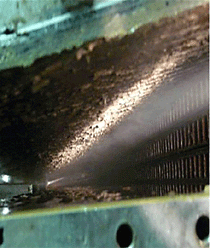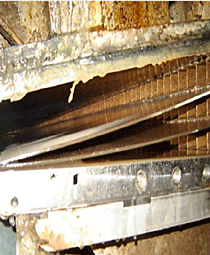

Additionally, incoming recycled fiber contains high levels of starch—a great food source for microorganisms. Strong oxidizers and organic biocides were the norm for microbiological control on such machines; however, these treatment options have significant drawbacks. Strong oxidizers are quickly consumed by system demand, while large amounts of organic biocides are required to maintain control, which makes for an expensive program. Poor microbiological control is costly too, as it can result in lost production, off-quality product, and odor issues.
Biofilm Penetration
Ashland's Spectrum™ XD3899 microbiocide has proved to be very effective at controlling microbiological activity in recycled packaging (it is the most widely used microbiological control program in the paper industry). As a mild oxidizer, it specifically reacts with microorganisms and is not consumed by the high demand common to recycled packaging systems. Not only is the XD3899 microbiocide effective against free-floating bacteria, but it is also capable of penetrating and eliminating biofilm.
The Poor with Poor Control
A significant problem associated with poor microbiological control in recycled packaging is lost production due to sheet breaks caused by biofilm in the wet end. With strong oxidizers and organic biocides, large amounts of biocide are required to maintain clean surfaces. However, because the XD3899 microbiocide is able to penetrate existing biofilm, an intermittent feed strategy can prevent large buildups at a significantly reduced cost.
Another recurrent issue among recycled packaging machines that have closed water systems is odor. Odor is the result of anaerobic bacteria producing volatile fatty acids (VFAs). Anaerobic bacteria thrive in low oxygen environments such as sludge and biofilm layers in chests. The XD3899 microbiocide not only kills these anaerobic bacteria but also eliminates the areas of buildup that allows them to reproduce. The microbiocide has proved itself repeatedly against strong oxidizers, such as ClO2 and sodium hypochlorite, at improved VFA control in recycled packaging systems.
Eliminating Headbox Deposition
A Southern U.S. recycled packaging machine was suffering from downtime associated with microbiological deposition in the headbox. Frequently, these headbox deposits would break loose and cause sheet breaks. Additionally, the mill had to shut down every five days to clean the headbox. Emergency boil-outs also contributed to downtime on the machine.
An intermittent feed of the XD3899 microbiocide to the thin stock loop reduced the downtime associated with microbiological depositions by more than 90%. The downtime from sheet breaks was reduced by more than 400 min. per month, while the downtime from headbox cleanings and boil-outs was reduced by more than 600 min. per month. The need for boil-outs on the machine was eliminated. The mill's return on investment with the XD3899 program was more than 900%.
Improving VFA Control
A U.S. linerboard machine with a furnish of 100% recycled OCC and a 100% closed water system had lost a large customer due to its inability to control VFAs during the hot summer months. The VFA levels were so high that they caused odor issues in the sheet. The existing ClO2 and carbamate program was incapable of controlling microbiological activity below the threshold that resulted in odor issues.
An XD3899 program was implemented and fed to the white water system five times per day at an equal cost to the previous program. The following benefits were noted by the mill:
The XD3899 program not only eliminated the mill's odor control problems, but also enabled it to increase productivity and reduce conductivity. The following photos show the headbox before the XD3899 program (left) and after the program (right).
 |
 |
About the Author
Erin Taylor is Applications Specialist-Microbiological Control, Ashland Inc. She can be contacted by email
TAPPI
http://www.tappi.org/